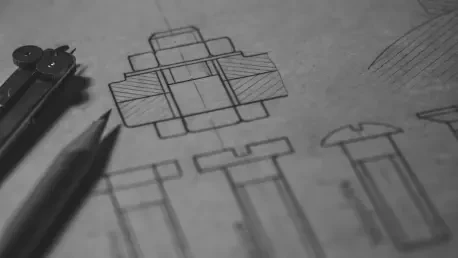In the intricate world of engineering and design, Computer-Aided Design (CAD) software stands as a cornerstone for converting conceptual ideas into precise 3D models that drive innovation across industries. Yet, the journey to mastering CAD is often a daunting one, demanding years of dedication to unravel its labyrinth of commands and functionalities that can overwhelm even the most determined learners. A transformative breakthrough from the Massachusetts Institute of Technology (MIT) offers a glimpse into a future where this complexity could be a thing of the past. Researchers have engineered an AI agent that autonomously translates 2D sketches into detailed 3D models by interacting with CAD software in a remarkably human-like manner. This development not only promises to simplify the design process but also aims to make CAD accessible to a broader audience, from seasoned engineers seeking efficiency to newcomers eager to explore 3D design without the steep learning curve. The implications of this technology could redefine how design workflows are approached, potentially reshaping industries reliant on precision and creativity.
Revolutionizing CAD with Artificial Intelligence
The challenge of navigating CAD software has long been a barrier, with its intricate interface and thousands of commands creating a steep learning curve for users at all levels of expertise. MIT researchers, under the guidance of graduate student Ghadi Nehme and Associate Professor Faez Ahmed, have tackled this issue head-on by developing an AI model that mirrors human interaction with CAD tools. This intelligent system interprets 2D sketches and executes the necessary actions—such as clicking specific buttons or dragging cursors—to build corresponding 3D models with precision. By automating these steps, the AI significantly reduces the time and effort traditionally required, offering a streamlined approach to design. The potential impact is substantial, as it lowers the entry threshold for beginners while providing experienced professionals with a tool to enhance productivity, making complex projects more manageable and less time-intensive.
This innovation represents more than just a technical achievement; it signals a shift in how design software can be perceived and utilized across various fields. Unlike traditional methods that demand extensive training to master CAD’s nuanced functionalities, the AI-driven approach prioritizes accessibility and speed. For industries where time-to-market is critical, such as automotive or architecture, this could translate into faster prototyping and iteration cycles. Moreover, the technology addresses a common frustration among users: the repetitive nature of certain design tasks. By handling these mundane aspects, the AI frees up human designers to focus on creative problem-solving and innovation. The MIT team’s work thus stands as a beacon of progress, illustrating how artificial intelligence can transform even the most technically demanding tools into intuitive aids that empower rather than intimidate.
Building on the VideoCAD Dataset Foundation
At the heart of MIT’s AI model lies an extensive and meticulously crafted resource known as the VideoCAD dataset, comprising over 41,000 videos that document human interactions with CAD software in granular detail. These recordings capture every aspect of the design process, from subtle mouse movements to specific keyboard inputs, providing a comprehensive guide for the AI to emulate human behavior accurately. Unlike previous datasets that offered only high-level command overviews, VideoCAD delves into the minutiae of user actions, enabling the AI to navigate CAD interfaces with a level of finesse previously unattainable. This depth of data ensures that the system can handle a wide range of designs, from simple mechanical components to complex architectural structures, all derived directly from initial 2D sketches.
The significance of VideoCAD extends beyond its role as a training tool; it represents a pioneering approach to bridging the gap between human intuition and machine execution in design software. Developing this dataset required translating abstract design intentions into concrete, pixel-level interactions, a process that demanded both technical expertise and an understanding of user behavior. The result is an AI that doesn’t merely follow scripted instructions but adapts to the nuances of CAD workflows as a human would. This capability marks a critical advancement, as it allows the technology to tackle diverse projects with varying levels of complexity. For the design community, VideoCAD’s detailed repository offers a foundation upon which future AI tools can be built, potentially standardizing how such systems learn and interact with intricate software environments.
Imagining a Collaborative CAD Co-Pilot
Looking beyond basic automation, the MIT team envisions their AI as a dynamic “co-pilot” that actively collaborates with users during the design process, enhancing both creativity and efficiency. This concept involves the AI not only generating 3D models from sketches but also providing real-time suggestions for subsequent design steps and automating repetitive sequences that often bog down workflows. Such a tool could fundamentally alter the user experience, acting as a supportive partner that anticipates needs and reduces manual input. For professional engineers, this means more time to focus on innovative solutions rather than tedious tasks, while for novices, it offers a guided entry into CAD without the intimidation of mastering countless features from scratch.
The potential for an AI co-pilot to democratize design cannot be overstated, as it opens doors for individuals lacking formal training to engage in sophisticated 3D modeling with confidence. Imagine a scenario where a hobbyist or student can sketch an idea and watch as the AI transforms it into a fully realized model, offering insights along the way to refine the output. This collaborative framework also aligns with the growing demand for tools that enhance human capabilities rather than replace them, fostering a synergy between technology and creativity. While still in its early stages, the idea of an AI co-pilot hints at a future where CAD becomes a shared endeavor, blending machine precision with human imagination to produce results that neither could achieve alone. The MIT initiative thus sets a precedent for how AI can evolve from a mere tool to a true partner in design.
Fitting into the Wave of AI-Driven Automation
MIT’s AI agent for CAD is a prime example of the broader technological trend toward AI-driven automation, where intelligent systems are increasingly designed to manage complex software interactions traditionally handled by humans. This movement is evident across various sectors, from data management to web navigation, and now extends into the specialized realm of design tools. Experts, including Mehdi Ataei from Autodesk Research, have hailed this project as a transformative milestone, noting its potential to simplify highly technical processes. The consensus is clear: integrating AI into CAD not only boosts productivity but also lays the groundwork for future innovations that could span multiple platforms and address even more intricate design challenges.
This trend reflects a growing recognition that user-friendly interfaces are essential for maximizing the adoption and impact of advanced tools like CAD in diverse industries. As AI agents become more adept at handling nuanced tasks, the scope of their application widens, promising to reshape workflows in fields such as manufacturing, engineering, and urban planning. The MIT model, while currently focused on specific interactions, could evolve to support varied CAD systems and adapt to less predictable, real-world design scenarios. Such advancements would further solidify AI’s role in making technical expertise more accessible, ensuring that cutting-edge tools are no longer the exclusive domain of highly trained specialists. This alignment with automation trends underscores the far-reaching implications of the research, positioning it as a catalyst for broader industry evolution.
Paving the Way for Future Design Innovations
Reflecting on the strides made by the MIT team, it’s evident that their AI agent marks a significant turning point in addressing the inherent challenges of CAD software complexity. Through the development of the VideoCAD dataset, they crafted a tool that not only automates the conversion of 2D sketches into 3D models but also introduces the visionary concept of an AI co-pilot for collaborative design. This work stands as a testament to the power of AI-driven automation, resonating with industry experts who see it as a foundational step toward transformative change. The focus now shifts to actionable next steps, such as expanding the AI’s compatibility with diverse CAD platforms and refining its ability to handle complex, real-world design scenarios. Additionally, fostering partnerships between academia and industry could accelerate the integration of such tools into everyday workflows, ensuring that both professionals and amateurs benefit from enhanced accessibility. As these efforts unfold, the legacy of this innovation will likely inspire a new era of design technology, where barriers are dismantled, and creativity knows no bounds.









